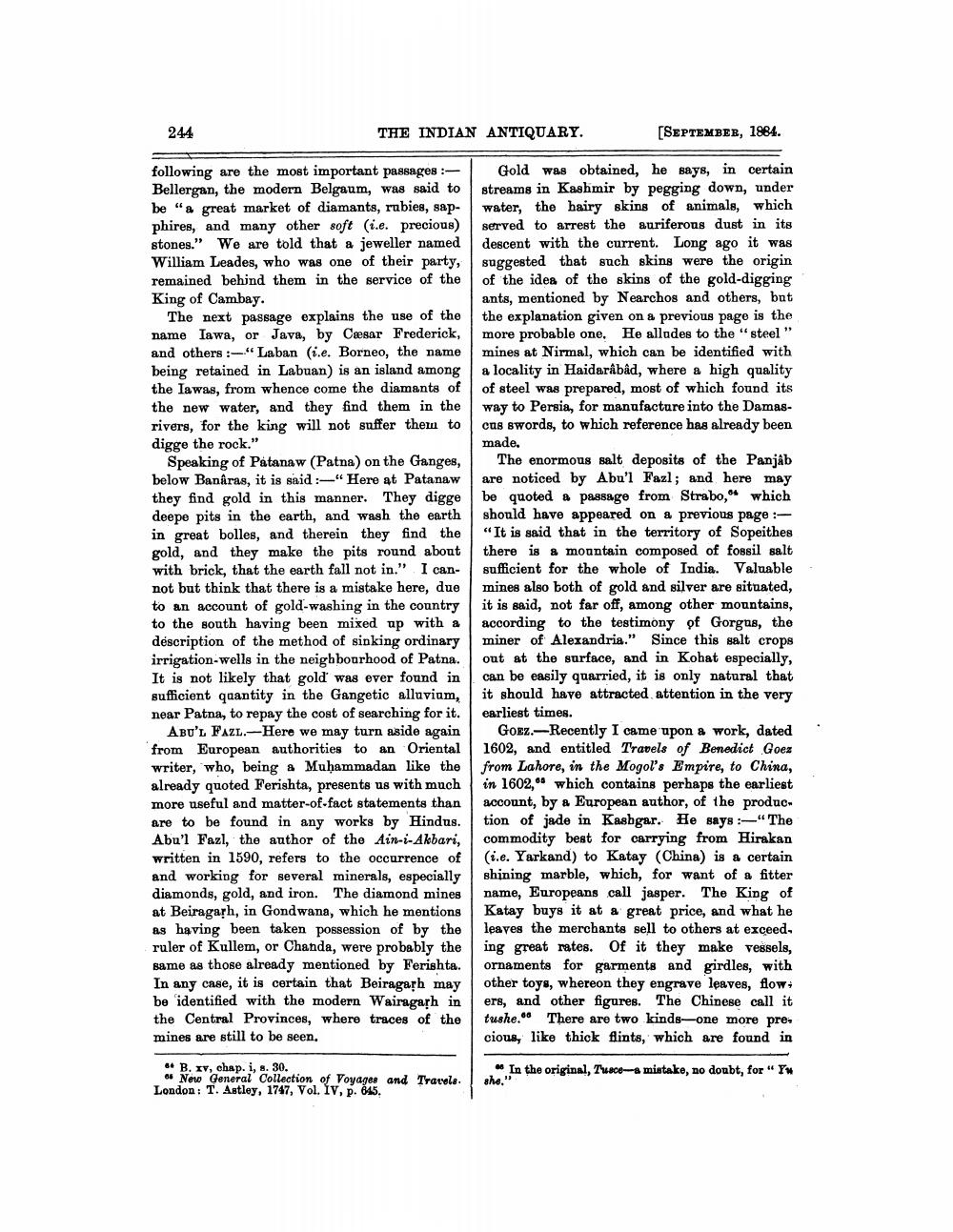________________
244
THE INDIAN ANTIQUARY.
following are the most important passages:Bellergan, the modern Belgaum, was said to be "a great market of diamants, rubies, sapphires, and many other soft (i.e. precious) stones." We are told that a jeweller named William Leades, who was one of their party, remained behind them in the service of the King of Cambay.
The next passage explains the use of the name Iawa, or Java, by Cæsar Frederick, and others: Laban (i.e. Borneo, the name being retained in Labuan) is an island among the Iawas, from whence come the diamants of the new water, and they find them in the rivers, for the king will not suffer them to digge the rock."
Speaking of Patanaw (Patna) on the Ganges, below Banaras, it is said:"Here at Patanaw they find gold in this manner. They digge deepe pits in the earth, and wash the earth in great bolles, and therein they find the gold, and they make the pits round about with brick, that the earth fall not in." I cannot but think that there is a mistake here, due to an account of gold-washing in the country to the south having been mixed up with a description of the method of sinking ordinary irrigation-wells in the neighbourhood of Patna. It is not likely that gold was ever found in sufficient quantity in the Gangetic alluvium, near Patna, to repay the cost of searching for it.
ABU'L FAZL.-Here we may turn aside again from European authorities to an Oriental writer, who, being a Muhammadan like the already quoted Ferishta, presents us with much more useful and matter-of-fact statements than are to be found in any works by Hindus. Abu'l Fazl, the author of the Ain-i-Akbari, written in 1590, refers to the occurrence of and working for several minerals, especially diamonds, gold, and iron. The diamond mines at Beiragarh, in Gondwana, which he mentions as having been taken possession of by the ruler of Kullem, or Chanda, were probably the same as those already mentioned by Ferishta. In any case, it is certain that Beiragarh may be identified with the modern Wairagarh in the Central Provinces, where traces of the mines are still to be seen.
[SEPTEMBER, 1884.
Gold was obtained, he says, in certain streams in Kashmir by pegging down, under water, the hairy skins of animals, which served to arrest the auriferons dust in its descent with the current. Long ago it was suggested that such skins were the origin of the idea of the skins of the gold-digging ants, mentioned by Nearchos and others, but the explanation given on a previous page is the more probable one. He alludes to the "steel" mines at Nirmal, which can be identified with a locality in Haidarâbâd, where a high quality of steel was prepared, most of which found its way to Persia, for manufacture into the Damascus swords, to which reference has already been made.
B. xv, chap. i, s. 30.
es New General Collection of Voyages and Travels. London: T. Astley, 1747, Vol. IV, p. 845.
The enormous salt deposits of the Panjab are noticed by Abu'l Fazl; and here may be quoted a passage from Strabo, which should have appeared on a previous page :"It is said that in the territory of Sopeithes there is a mountain composed of fossil salt sufficient for the whole of India. Valuable mines also both of gold and silver are situated, it is said, not far off, among other mountains, according to the testimony of Gorgus, the miner of Alexandria." Since this salt crops out at the surface, and in Kohat especially, can be easily quarried, it is only natural that it should have attracted attention in the very earliest times.
65
GOEZ. Recently I came upon a work, dated 1602, and entitled Travels of Benedict Goez from Lahore, in the Mogol's Empire, to China, in 1602, which contains perhaps the earliest account, by a European author, of the produc tion of jade in Kashgar. He says:-"The commodity best for carrying from Hirakan (i.e. Yarkand) to Katay (China) is a certain shining marble, which, for want of a fitter name, Europeans call jasper. The King of Katay buys it at a great price, and what he leaves the merchants sell to others at exceed. ing great rates. Of it they make vessels, ornaments for garments and girdles, with other toys, whereon they engrave leaves, flow. ers, and other figures. The Chinese call it tushe. There are two kinds-one more pre cious, like thick flints, which are found in
In the original, Tusce-a mistake, no doubt, for " Y she."




